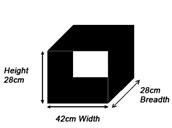Chargable weight Calculations
1) CALCULATION OF WEIGHT BY VOLUME MEASUREMENTS vs ACTUAL WEIGHT
Because we send your shipments on a commercial aircraft, we are required to declare both the correct size and the actual weight of the shipment. The basis for applying a charge to your consignment is the greater of the actual weight or the volume weight of your consignment.
The chargeable weight is the greater of the actual weight in kilograms versus the volumetric weight in kilograms.
The international airline conversion formula to determine the volume weight is the converting of cubic centimeters to kilograms by applying the formula of 6000 cubic cms = 1 kilogram (or 1 m3 = 167Kgs).
For example: Take the below box shown that has an actual weight of 4 kilograms.
Taking the package measurements of 28cm (H) x 43cm (W) x 28cm (B) this equates to .0337m3 (0.28 x0.43 x0.28 = .0337m3 )

Applying the airline formula for volume weight conversion the package has a volumetric weight of 5.63kgs (.0339 x 167kgs = 5.63 kilograms). As this is greater than the 4kgs of actual weight the chargeable weight for this shipment would be 6 kilograms (conversions are rounded up to the next .50 of a kilogram).
This is important to understand so you are clear on how your freight charges will be calculated. From this you can work if the volumetric weight rule applies to your items and enable you to anticipate shipment costs accurately.
HINT: If the volume rule applies, look to increase the actual weight packed within the package, without increasing the size of your package, by including some extra products to improve the landed cost per unit within your shipment.
2) LABELLING
All packages tendered for shipment must be individually addressed with the full physical address for delivery including contact persons and telephone numbers and the like. It is important to also show area codes and particuarly Zip codes for USA deliveries.
|


